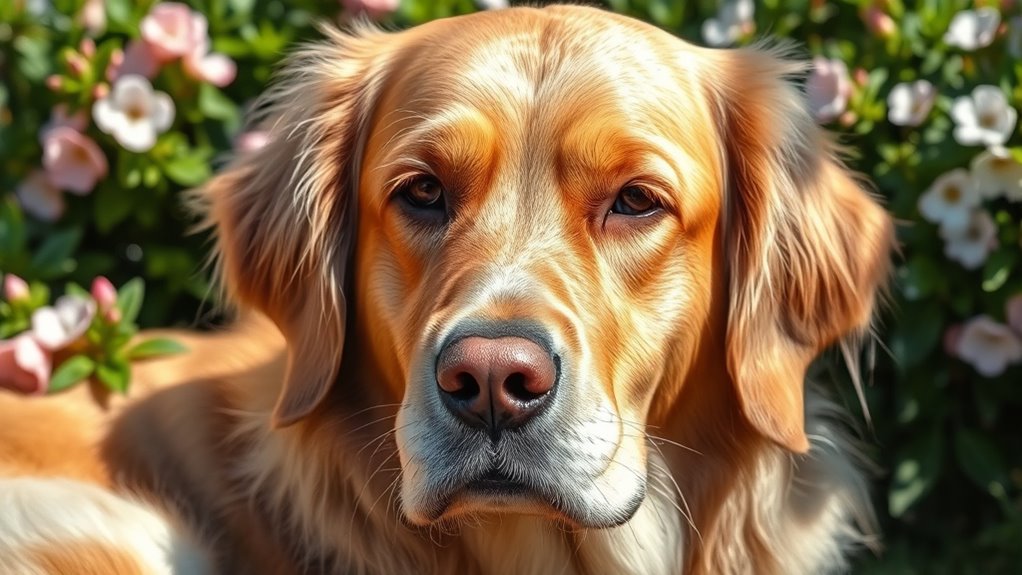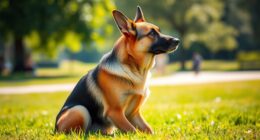When adopting a senior dog, you’ll find they need special care, patience, and understanding of their unique health and emotional needs. Expect to adjust routines, provide regular veterinary care, and make environmental modifications to keep them comfortable. Building trust takes time, gentleness, and consistent interactions. As you support their physical and emotional well-being, you’ll create a loving bond and ensure their golden years are happy. To learn more about making this journey successful, keep exploring these important steps.
Key Takeaways
- Senior dogs require tailored care for age-related health issues, including regular vet visits and appropriate grooming.
- Adjust routines and environment with patience, gentle support, and modifications like ramps or orthopedic beds.
- Building trust involves consistent, gentle interactions, positive reinforcement, and understanding their body language.
- Nutritional needs focus on high-quality, easily digestible foods with joint-support nutrients, combined with gentle exercise.
- Proper planning includes medical records organization, financial preparedness, and understanding end-of-life care to ensure comfort and dignity.
Understanding the Unique Needs of Senior Dogs

Have you ever wondered what makes senior dogs different from younger ones? Their needs change as they age, requiring a different approach to care. Senior dogs still enjoy playful activities, but these should be tailored to their energy levels and physical capabilities. Gentle, low-impact games help keep them active without overstressing their joints. Grooming considerations also shift; older dogs may need more frequent brushing to manage shedding and maintain skin health. Their coats might be thinner or more fragile, so you should handle grooming delicately. Additionally, watch for signs of discomfort or skin issues. Maintaining their emotional well-being through music therapy can also be beneficial. Being aware of retail hours for pet supplies ensures you have the necessary grooming products and health items when needed. Understanding the importance of regular veterinary checkups can help catch age-related health issues early. Paying attention to body condition can help prevent obesity or malnutrition, which are common concerns in senior dogs. It’s also helpful to learn about senior dog nutrition to support their changing dietary needs. By understanding these unique needs, you’ll ensure your senior dog stays comfortable, happy, and healthy in their golden years.
Health and Medical Considerations

Caring for a senior dog’s health requires close attention to their medical needs, as aging can bring about various health issues. Regular veterinary visits are essential to monitor their condition and update their vaccination schedule. You should also prioritize dental care, as dental problems are common in older dogs and can lead to other health complications. Here are four key considerations:
- Schedule routine vet checkups to catch health issues early.
- Keep vaccinations current to protect against preventable diseases.
- Maintain consistent dental care, including brushing and professional cleanings.
- Watch for signs of age-related conditions like arthritis or vision loss, and consult your vet for management options.
- Understanding the importance of diagnostic accuracy in medical imaging can aid in accurate diagnoses and treatment planning. Regular health assessments and advancements in diagnostic technology can significantly improve your dog’s quality of life during their senior years.
Being proactive helps ensure your senior dog stays comfortable and healthy in their golden years.
Adjusting to New Routines and Environment
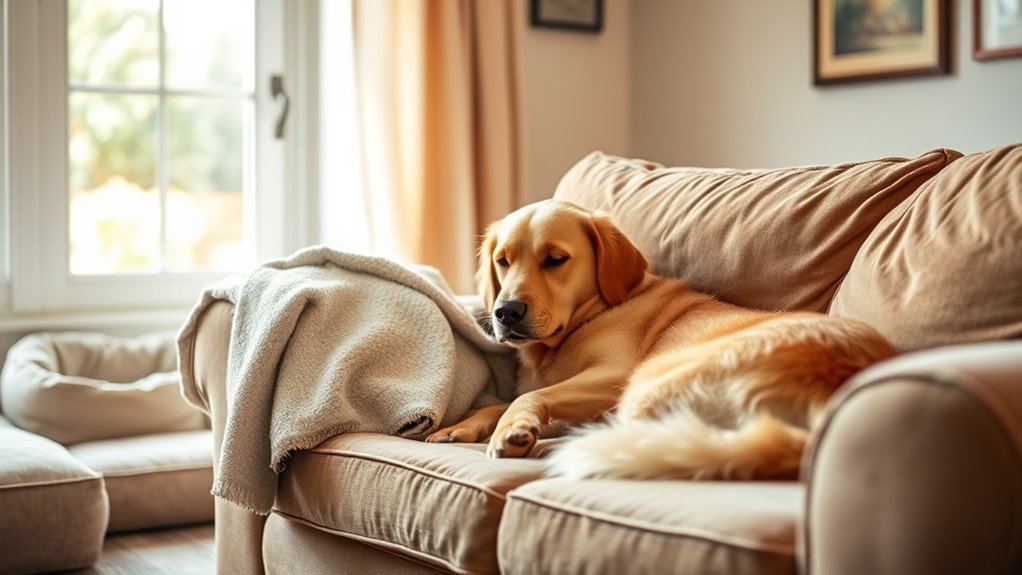
Adapting a senior dog to new routines and environments requires patience and consistency, as older dogs can be more sensitive to change. Start with simple training tips, such as establishing a consistent schedule for walks, feeding, and bathroom breaks, which helps your dog feel secure. When introducing grooming routines, be gentle and use positive reinforcement to make the experience less stressful. Keep a calm environment and gradually introduce new spaces, giving your dog time to explore at their own pace. Stick to familiar routines as much as possible, and be attentive to your dog’s cues. Establishing a regular yoga practice with gentle poses and breathing exercises can help both you and your dog stay relaxed and adaptable during this transition. With patience, gentle guidance, and clear routines, your senior dog will gradually adjust and feel more comfortable in their new home. Additionally, understanding signs of spoilage in lemon juice can help ensure that any treats or supplements used during training are safe and fresh. Paying attention to indoor air quality can also contribute to a healthier environment for your dog, especially if they have sensitivities. Being aware of remote hackathons can serve as a way to engage with the broader community and find new opportunities for enrichment and socialization. Incorporating tuning techniques for your dog’s needs can further support their comfort during this transition.
Recognizing and Accommodating Aging Behaviors
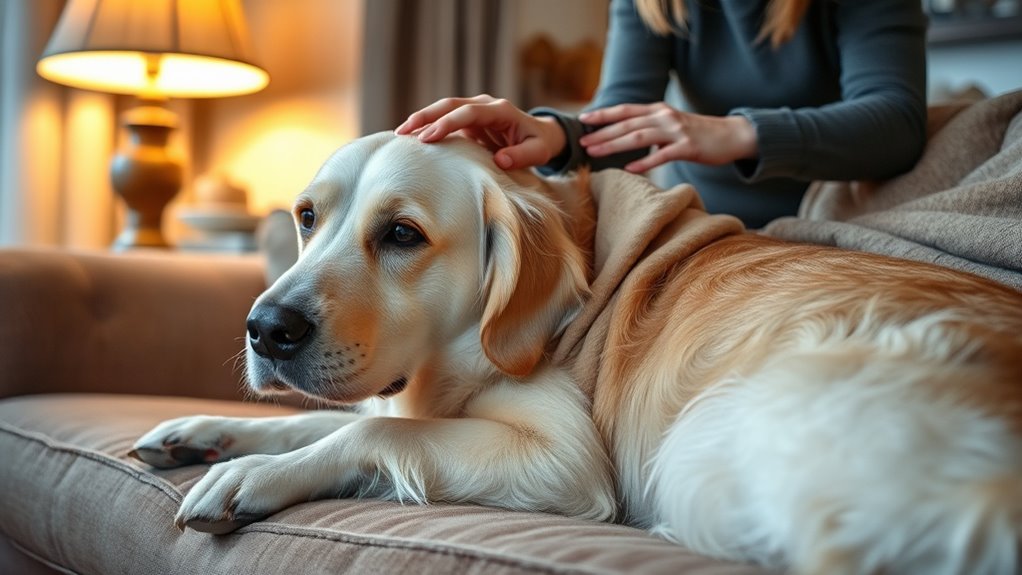
As your senior dog ages, you’ll notice changes in their behavior that indicate their needs are evolving. Recognizing these signs helps you better support their well-being. Aging dog communication may shift, and senior dog behavior can include decreased activity, increased sleeping, or reluctance to go for walks. You might see them vocalize differently or become more withdrawn. To accommodate these changes, consider their comfort and health. Monitoring vetted products like orthopedic beds or ramps can greatly improve their quality of life. Being aware of common aging behaviors enables you to provide appropriate adjustments and care. For example, understanding elderly dog communication can help you interpret their needs more accurately. Recognizing holistic wellness approaches can also contribute to their overall health. Here are some key signs to watch for:
- Reduced activity or playfulness
- Increased sleeping or rest periods
- Changes in vocalization patterns
- Difficulty maneuvering stairs or uneven surfaces
Understanding these aging dog behaviors and their underlying causes allows you to adapt your care, ensuring your senior dog feels safe and loved.
Nutrition and Exercise for Older Dogs

Have you considered how your senior dog’s nutritional needs and exercise routines should change as they age? Proper diet planning becomes essential to support their health and manage age-related issues. Focus on high-quality, easily digestible foods with adjusted calorie intake to prevent weight gain. Look for diets enriched with joint-supporting nutrients like glucosamine and chondroitin. When it comes to exercise routines, keep activity gentle and consistent to avoid overstressing their joints or causing fatigue. Shorter, more frequent walks and low-impact activities like swimming can help maintain muscle tone and flexibility. Additionally, being aware of age-related health changes can help you adapt their care accordingly. Recognizing AI-driven health monitoring tools and technology can assist in tracking your dog’s health more effectively. For example, some performance tuning devices can monitor vital signs and activity levels, providing valuable data for your vet. Always observe your dog’s responses and consult your vet to tailor their nutrition and exercise plan. Regular vet check-ups are crucial to monitor their evolving health needs. Proper care guarantees your senior dog stays comfortable, active, and happy in their golden years.
Building Trust and Bonding
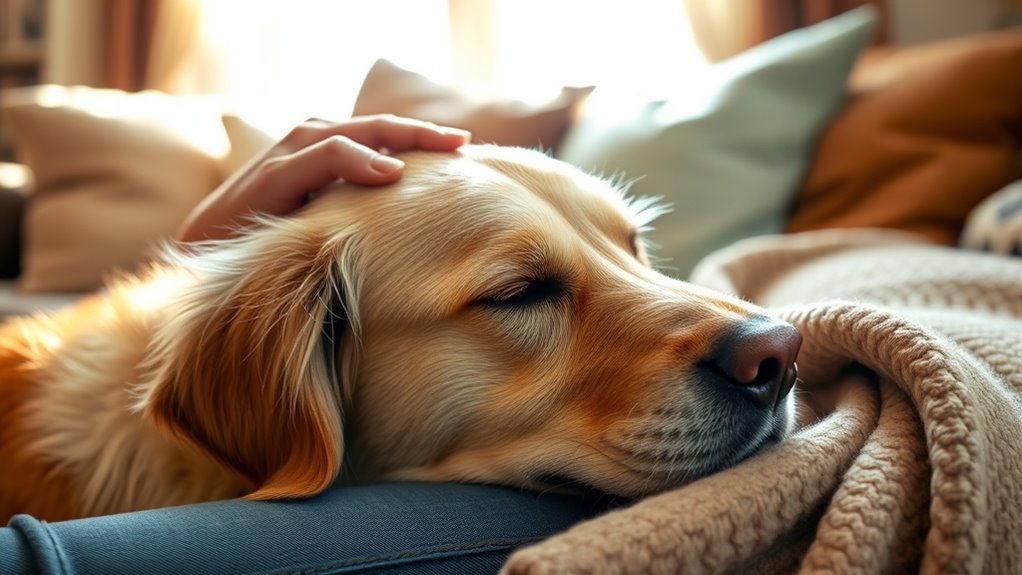
To build trust with your senior dog, you need to be patient and consistent in your interactions. Use gentle techniques like soft voice, calm movements, and positive reinforcement to help them feel safe. Over time, these efforts will strengthen your bond and create a sense of security for your new companion. Cultivating a bias to action by regularly engaging in positive interactions can also foster a stronger connection. Additionally, understanding the importance of retirement planning and providing a stable environment can help your senior dog adapt more comfortably. Incorporating essential oils for calming may also support your dog’s relaxation and ease anxiety during this transition. Using self watering plant pots as a metaphor, providing consistent care and attention helps your dog thrive and feel nurtured.
Patience and Consistency
Building trust with a senior dog requires patience and consistency, especially since they may have experienced neglect or instability in the past. Your steady approach helps them feel secure as they adjust. Use gentle training methods to reinforce good behavior, and establish predictable grooming routines to build comfort. Consistency in your actions reassures your dog and speeds up the bonding process.
- Stick to simple, positive training methods.
- Maintain a regular grooming schedule.
- Set clear boundaries and routines.
- Be patient if progress is slow.
Gentle Interaction Techniques
Establishing trust with a senior dog begins with gentle, respectful interactions that convey safety and reassurance. Use a calming voice to create a peaceful environment, and approach gradually to avoid startling them. Offering a gentle touch helps build comfort and connection. Pay attention to their body language and respond calmly to signals of stress or fear. Consistency in your actions and tone reassures your dog that they’re safe with you. Try this simple approach:
| Technique | Purpose | Result |
|---|---|---|
| Gentle touch | Builds comfort and trust | Dog feels safe and loved |
| Calm voice | Reduces anxiety | Dog stays relaxed |
| Slow movements | Prevents startling | Dog remains calm |
These techniques foster a strong bond and ease your senior dog into their new home.
Planning for the Future and End-of-Life Care
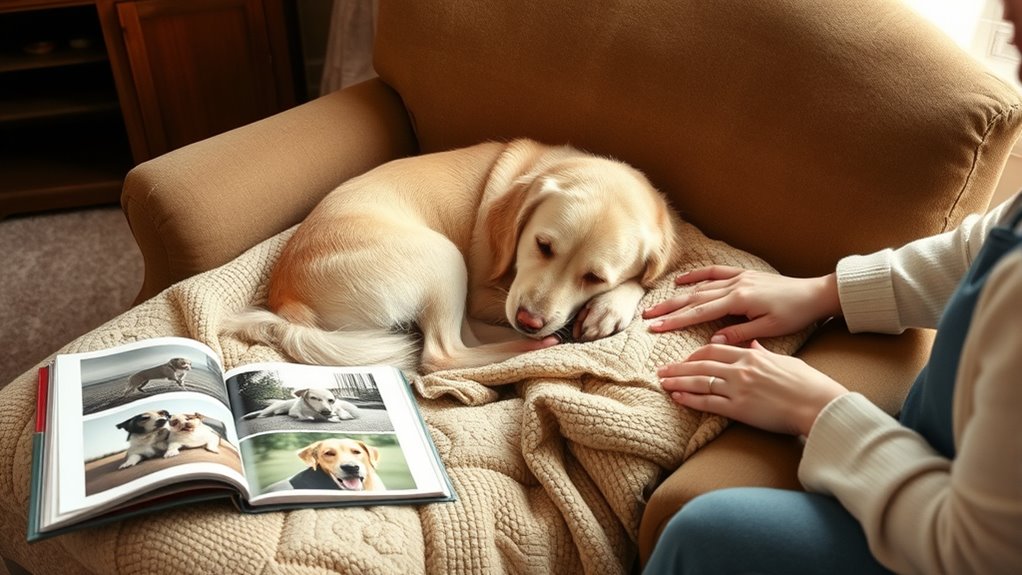
Planning for your senior dog’s future means gathering their medical history and records now, so you’re prepared for any health issues. You’ll also want to contemplate financial planning to cover ongoing care and unexpected emergencies. Additionally, think about how you’ll provide emotional support and maintain routines to keep your dog comfortable as they age.
Medical History & Records
Have you gathered your senior dog’s complete medical history and records? This step is essential for understanding their health needs and planning for the future. Confirm you have:
- Vaccination history, including boosters and any recent updates
- Records of past medical treatments and surgeries
- Diagnoses of chronic conditions or allergies
- Details of any medications your dog is currently taking
Having these records helps your veterinarian assess your dog’s health and make informed decisions. It also ensures continuity of care and helps you recognize potential health issues early. Keep these documents organized and up-to-date. Knowing your dog’s medical background provides peace of mind and prepares you for responsible end-of-life care, including pain management and comfort measures.
Financial Planning Needs
Having your senior dog’s medical records organized helps you anticipate future healthcare costs and make informed decisions about their care. As your dog ages, veterinary costs can increase, especially for chronic conditions or unexpected emergencies. Planning financially means setting aside funds or considering pet insurance to offset these expenses. Insurance planning guarantees you’re prepared for costly procedures without compromising your dog’s well-being. It’s wise to review policies carefully, focusing on coverage for senior-specific health issues. Additionally, consider setting aside a dedicated emergency fund for unforeseen needs. By proactively managing these financial aspects, you can focus on providing quality care and comfort for your senior dog without the stress of unexpected expenses. Proper planning helps ensure a dignified, pain-free life for your loyal companion.
Emotional & Routine Support
As your senior dog’s needs change, providing consistent emotional and routine support becomes essential for their comfort and well-being. Establishing familiar routines helps reduce stress and encourages trust. To support their emotional health, focus on gentle playtime activities that suit their energy level, fostering bonding and mental stimulation. Maintain regular grooming routines to keep them comfortable and identify health issues early. Consider these key areas:
- Schedule consistent daily routines, including feeding and walks
- Engage in gentle playtime activities tailored to their mobility
- Keep grooming routines regular to promote comfort and health
- Provide reassurance during times of change or stress
Frequently Asked Questions
How Can I Tell if a Senior Dog Is a Good Fit for My Family?
To determine if a senior dog is a good fit for your family, assess their adoption readiness and family compatibility. Observe their behavior around kids and other pets, and consider their energy level and health needs. Spend time with the dog beforehand to see if their temperament matches your lifestyle. If they seem relaxed and adaptable, they’re likely a good match. Trust your instincts and consult with shelter staff for guidance.
What Are Signs of Common Age-Related Health Issues?
You notice signs of age-related health issues like joint pain, vision decline, and reduced energy. These signs tell you your senior dog might be experiencing arthritis, cataracts, or hearing loss. You observe their movements, monitor their responsiveness, and seek veterinary advice when needed. Recognizing these signs helps you provide better care, comfort, and support, ensuring your dog’s golden years are happy and healthy.
How Do I Introduce a Senior Dog to My Home Without Stress?
When introducing your senior dog to your home, start by puppy-proofing the space to guarantee safety. Keep a calm environment and slowly introduce familiar items. Stick to gentle exercise routines, avoiding sudden movements or strenuous activity. Allow your dog to explore at their own pace, offering plenty of praise and comfort. This thoughtful approach helps reduce stress, making the passage smooth and enjoyable for your new senior companion.
Are There Special Training Needs for Senior Dogs?
Did you know that 75% of senior dogs benefit from tailored training? You’ll need to make training adaptations, focusing on gentle, clear commands and patience. Activity modifications are essential; senior dogs often have limited stamina and may have joint issues. Keep training sessions short and positive, and always respect their pace. With these adjustments, your senior dog can learn comfortably and happily, strengthening your bond over time.
How Can I Support a Senior Dog’s Emotional Well-Being?
You can support a senior dog’s emotional well-being by creating comforting routines that provide stability and security. Incorporate music therapy, playing gentle, calming music to soothe them during stressful times. Spend quality time together, offering gentle petting and reassuring words. Consistency helps them feel safe, and engaging in familiar activities strengthens your bond. These efforts help reduce anxiety and promote overall emotional health for your senior dog.
Conclusion
Adopting a senior dog isn’t just about giving them a comfy bed and a few treats; it’s about embracing the joys (and occasional surprises) of their golden years. Sure, you might get extra cuddles and fewer zoomies, but be prepared for vet visits and a few “special” habits. Ultimately, if you’re ready to master patience and embrace the quirks, you’ll find that the love from a senior dog is truly priceless—minus the puppy chaos.

